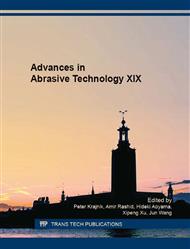p.475
p.481
p.487
p.492
p.497
p.505
p.511
p.519
p.525
Surface Roughness and Topography Analysis in Precision Milling of 3J33 Maraging Steel
Abstract:
In precision milling, the quality of surface finish is an important requirement for workpiece machined. Thus, optimization of cutting parameters is important for controlling the surface quality. In this study, the Taguchi method is used to find the effects of milling parameters on surface roughness in precision milling of 3J33 maraging steel. A model, which is based on the milling parameters and tool geometry, is also proposed in order to predict the surface topography. The experimental results show that milling speed has significant effect on the surface roughness among the milling parameters. Besides, tool geometry and material deformation play important roles in the surface topography.
Info:
Periodical:
Pages:
497-502
Citation:
Online since:
October 2016
Authors:
Keywords:
Price:
Сopyright:
© 2016 Trans Tech Publications Ltd. All Rights Reserved
Share:
Citation:


